As we covered at YTHK a few months ago, Cathay Pacific will devalue its award chart (or, change some prices on tickets redeemed with Asia Miles) on the 1st of October, 2023. While Alvin’s post provides a pretty comprehensive summary of the changes with Cathay’s new award chart, I wanted to build on it to offer some of my thoughts.
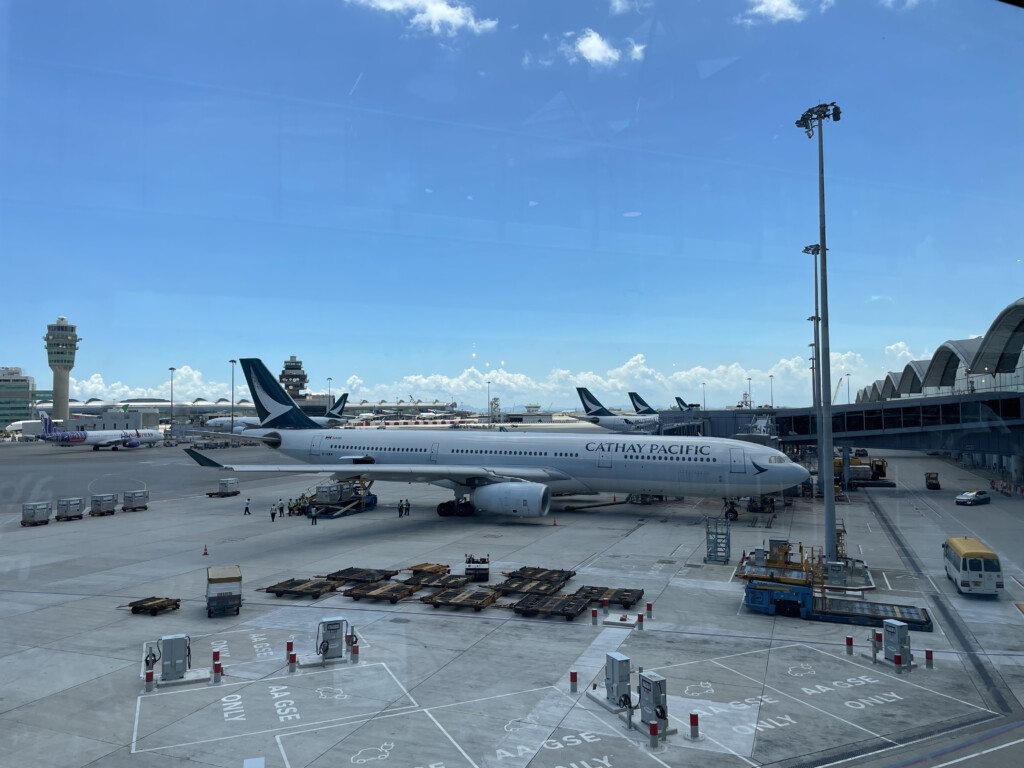
Cathay Pacific A330-300
Let’s talk terminology
Before I get started on breaking down some of the changes, I’m going to define a few terms to avoid confusion.
- Cathay Pacific is the Hong Kong-based airline.
- Cathay is the name of Cathay Pacific’s loyalty programme. It’s also a “lifestyle brand”, but we’re not going to get into that in this post. You can read more about the programme in our guide here.
- Asia Miles is the mileage “currency” of the Cathay programme.
- Premium Cabins refer to Premium Economy, Business, and First. While there’s some debate over whether or not Premium Economy counts as a “premium” class of travel, in the context of the changes to Cathay’s award chart, the changes that we’re seeing to Premium Economy redemption rates are more similar to changes to Business/First redemptions, rather than Economy redemptions.
As another caveat, I’m going to focus on award and upgrade redemptions on Cathay Pacific-operated flights for this post.
About that email…
On the 6th of July, Cathay Pacific announced it was devaluing its award chart. In an email, the airline justified its decision to devalue its award chart on the basis that the programme award chart hadn’t been updated since 2018. I find this argument to be fair; in the ensuing five years, the airline has gone through a tough time. Ticket pricing – especially in the Asia Pacific region – has also gone up drastically from 2018 levels.
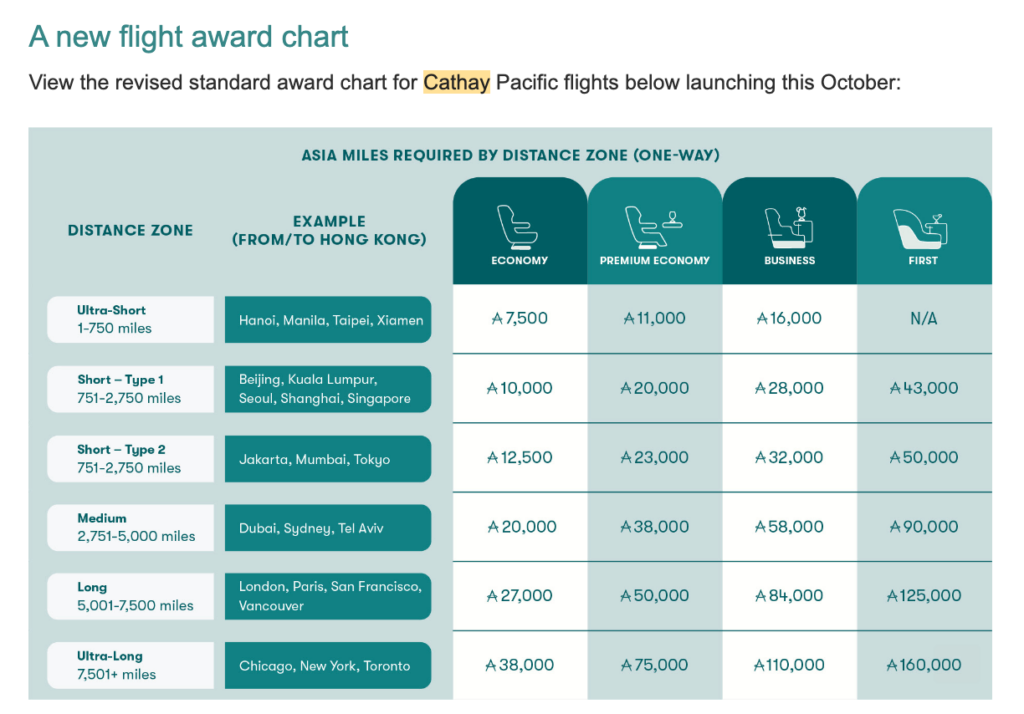
What I found a little more disingenuous was the following sentence:
“Back in January, we committed to doubling the number of award seats available per Cathay Pacific flight this year as there were in 2019. To continue offering you increased seat availability, we’ve decided to introduce the following changes”
I’m a little skeptical about this argument:
- Has Cathay Pacific actually doubled the number of award seats available per flight compared to 2019 levels? Based on what I’ve seen, it’s harder to get book a long-haul award seat (especially in premium cabins) than it is to get a ticket for Taylor Swift’s Eras Tour.
- The idea that Cathay has increased award prices to “[offer] increased seat availability” is… well… I’m not quite sure what to say about that.
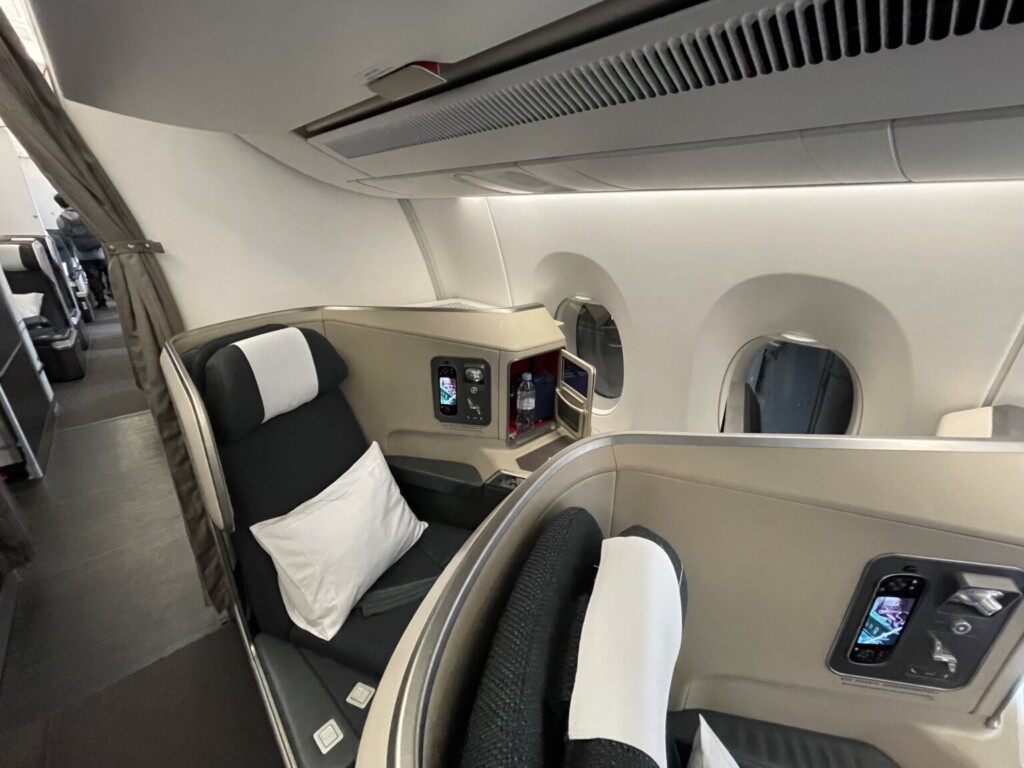
Cathay Pacific A350-900 Business Class
It could’ve been worse
While the wording in the email is a little disingenuous, Cathay Pacific is far from the only airline to spin an award chart devaluation as a positive. That being said, I feel that the devaluation could have been far worse.
- These new changes are kicking in three months after the initial announcement. I appreciate the advance notice given, even if it’s not good news. It is, however, worth noting that award space on Cathay Pacific flights has been lacking in the past few months.
- Cathay is bucking an industry trend by not implementing dynamic award pricing – which means that award prices won’t go up and down in times of high and low demand respectively.
- In most cases, redemptions haven’t gone up as much as some price increases we’ve seen across other frequent flyer programmes recently.
The devaluation isn’t nearly as bad when considering some recent developments with the Cathay programme:
- When Cathay Pacific last updated its “Cathay” loyalty programme in 2022, Asia Miles earnings for many tickets actually increased by around 10-15%;
- Cathay also (somewhat) recently introduced a “Miles + Cash” option to purchase flight tickets, and is also promoting Asia Miles as a currency for various consumer goods. However, the going rate to “replace” 1 Hong Kong Dollar with miles for flights and goods is 25 Asia Miles, which is terrible value. I was worried that the new mileage rates would reflect the new value of Asia Miles based on these developments. Thankfully, they’re not.
All things considered, while no devaluation is good news for frequent flyers, these updates are about as not-bad as it gets.
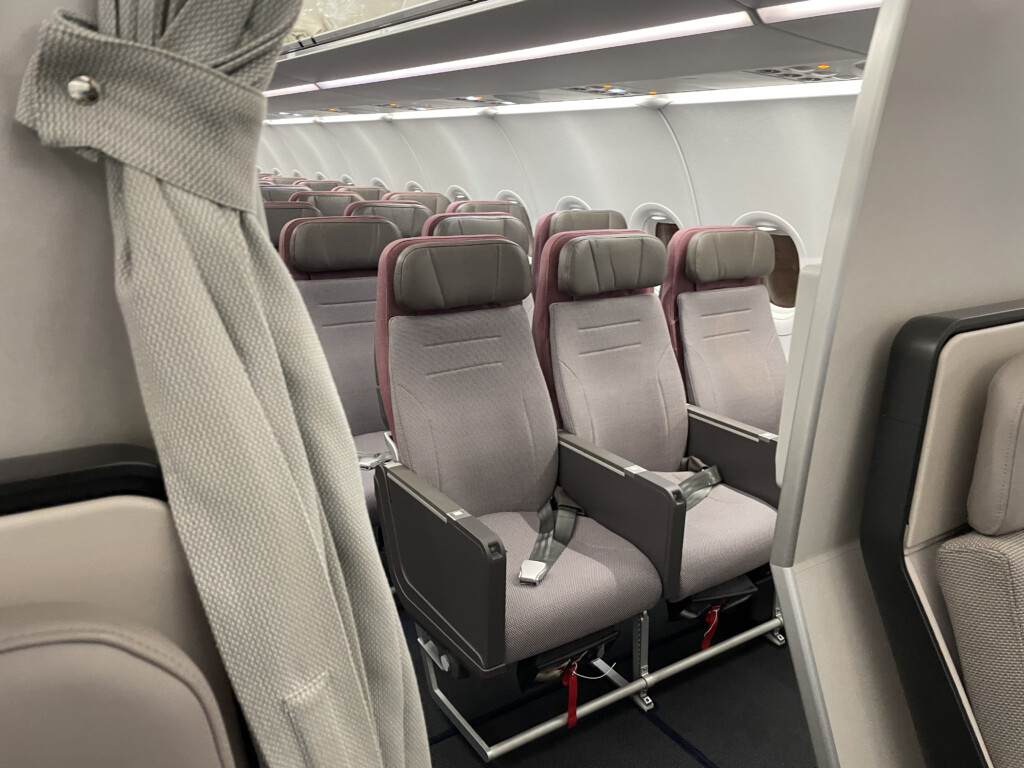
It could’ve been worse, especially if you’re mainly using miles for short-haul Economy flights
Hong Kong media outlets have coined the catchphrase “短加長減” (which directly translates to “short add long subtract” – I promise it makes more sense in Cantonese) to describe the changes. However, I feel that this description oversimplifies the devaluation and makes the changes seem much more positive than they actually are. With that in mind, here are a few of my observations.
New award chart zones
One of the big changes to Cathay’s award charts is that redemptions for “short” flights will be split into two types, while all long flights will be merged into one distance zone.
Historically, all “Short” flights (751-2,500 miles) were grouped into one distance zone. However, in the new programme, “Short” flights will be grouped into two types: Short – Type 1 and Short – Type 2.
- Short – Type 1 flights are shorter and/or cheaper. Examples given by Cathay include flights to Beijing, Shanghai, Seoul, Kuala Lumpur, and Singapore. It’s probably easier to think of Short – Type 1 route as any route between 751 and 2,500 in length that isn’t a Short – Type 2 route.
- Short –Type 2 flights are longer and/or command a higher price. Examples given by Cathay include redemptions for Jakarta, Mumbai, and Tokyo. I’m guessing that this zone will include further and/or pricier destinations in Japan (e.g. Osaka and Sapporo), all flights to South Asia (e.g. Bengaluru, Kathmandu, Colombo), and flights to Indonesia (e.g. Denpasar, Surabaya). Type 2 awards cost 25% more than Type 1 awards.
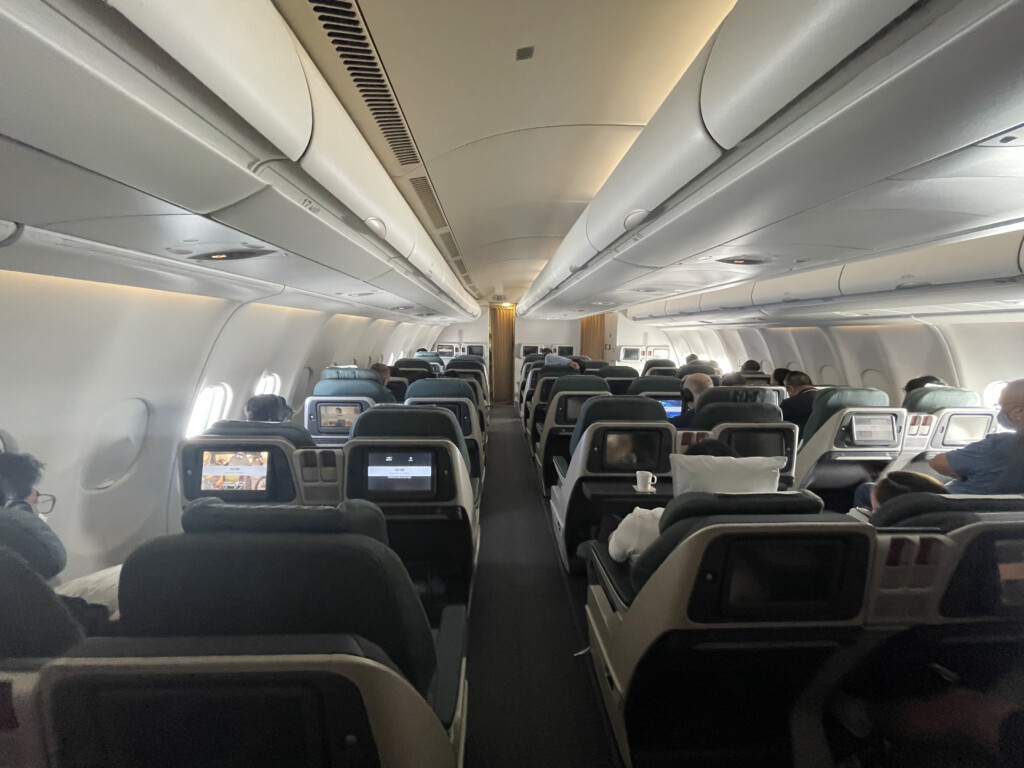
Same regional Business seat, different award prices
Meanwhile, all “Long” flight redemptions will be merged into one distance zone. Under the old system, “Long” flights were grouped into Type 1 destinations (destinations in Europe/South Africa/New Zealand) and Type 2 destinations (all North American West Coast destinations). The new system merges these two categories into a single distance zone.
This change makes sense: in light of the Russian invasion of Ukraine, flights from Hong Kong to Europe take 2-3 hours longer due to the need to reroute aircraft to avoid Russian airspace. Hence, the discrepancy between flight times of the two categories of “long” flights isn’t big enough to necessitate a separate distance zone.
The new one-way award chart:
The table below summarises the following:
- The price (in Asia Miles) for a one-way, award seat redemption on a Cathay Pacific-operated flight under the old system;
- The price (in Asia Miles) for a one-way, award seat redemption on a Cathay Pacific-operated flight under the new system; and
- The percent change between the old and new prices.
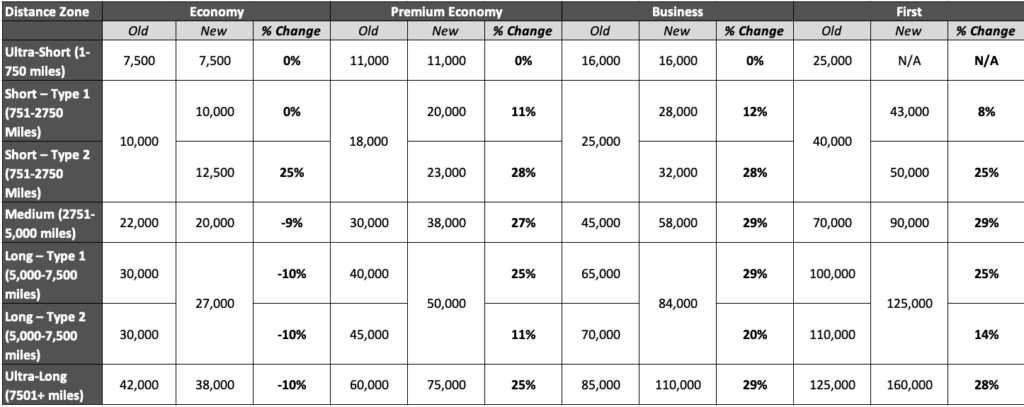
Source: Cathay Pacific
General trends of the new award chart
1. Ultra-short redemptions stay the same across all cabins.
Good news for travellers looking to cash in their Asia Miles for a short hop – Asia Miles redemption rates will stay the same. Considering how ridiculously expensive cash tickets for ultra-short flights have become, ultra-short redemptions may become a new “sweet spot” within the programme.
2. Economy redemptions (generally) get cheaper.
The introduction of a Short – Type 2 zone will increase some short-haul awards by 25%. However, award prices have decreased by around 10% for medium, long, and ultra-long Economy redemptions. These changes are smart, and consistent with Cathay’s push to broaden the appeal of its loyalty programme.
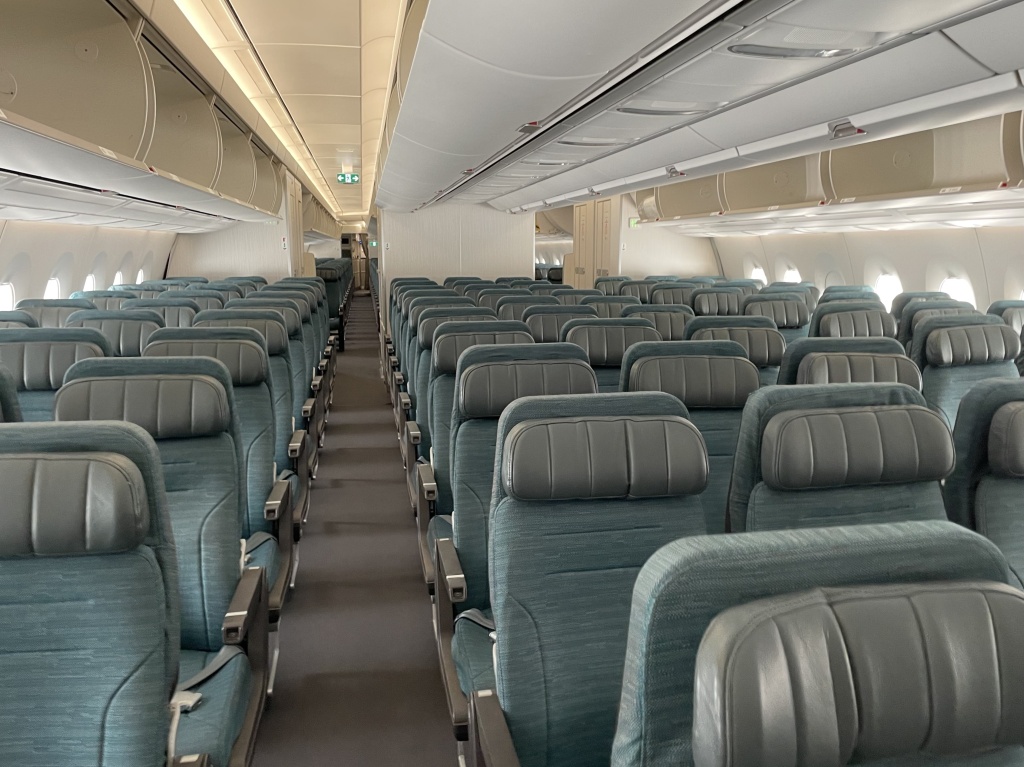 Cathay Pacific A350-1000 Economy Class
Cathay Pacific A350-1000 Economy Class
- An Economy redemption ticket is great for Cathay – and a horrible use of miles for passengers. Realistically, Cathay Pacific doesn’t sell out every single flight, especially in Economy cabins with hundreds of seats. Hence, by making Economy redemptions more attractive, Cathay takes away a sizeable chunk of frequent flyer miles from a member for very little opportunity cost. In fact, I’m willing to bet that Cathay will mostly increase Economy redemption availability to meet its promise to “double award seats from 2019 levels”.
- Cathay is currently trying to expand its programme’s reach beyond savvy travellers to the general public, many of whom don’t care about premium cabin travel. The drop in long-haul Economy redemption rates appears to be an attempt to broaden the Cathay programme’s mass-market appeal.
3. Premium cabin redemptions increase across the board
The cost of award tickets for travel in Premium Economy, Business, and First on short, medium, long, and ultra-long flights have generally increased by around 25-30% across the board. Asia Miles increases are particularly steep for Business award tickets. These prices increases generally bring Cathay’s award chart in line with those of its Asian competitors, including Singapore Airlines’ KrisFlyer programme.
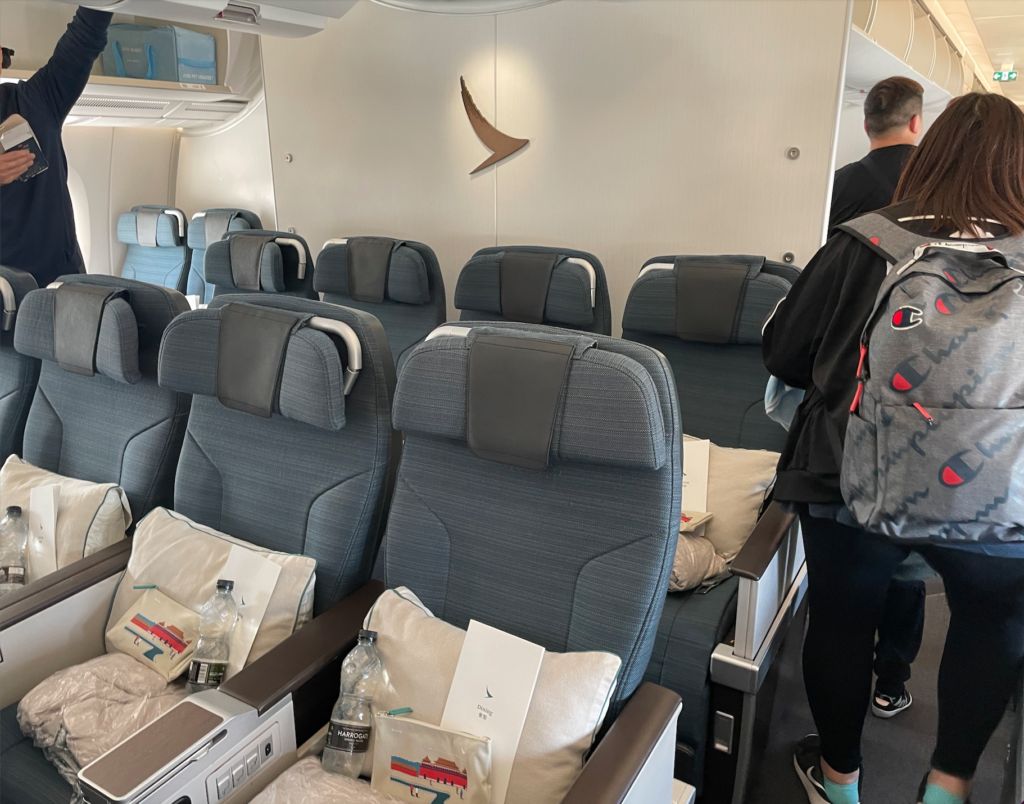
Cathay Pacific A350 Premium Economy
Notably, redemption rate increases for routes in the newly created Short – Type 1 category are around 10%, which isn’t as steep as some of the other redemption rate increases. The same goes for flights previously under the Long – Type 2 category, for which redemption hikes range from 10-20%.
While the changes aren’t great, they aren’t nearly as ridiculous as some of the other devaluations that we have seen across the airline industry recently.
Most notably – the price increases are generally consistent across both flight length and cabin class, indicating that this isn’t an attempt to gut premium awards (which, truthfully, weren’t especially attractive prior to the devaluation anyways…)
The new upgrade chart
This is where things get a bit messy.
For a bit of background, Cathay members can redeem one-way Asia Miles upgrades to the next cabin class on any flight. Upgrade rewards are typically only available if there is redemption seat availability in the next cabin class.
The table below summarises the following:
- The price (in Asia Miles) for a one-way, upgrade award redemption on a Cathay Pacific-operated flight under the old system;
- The price (in Asia Miles) for a one-way, upgrade award redemption on a Cathay Pacific-operated flight under the new system; and
- The percent change between the old and new prices.
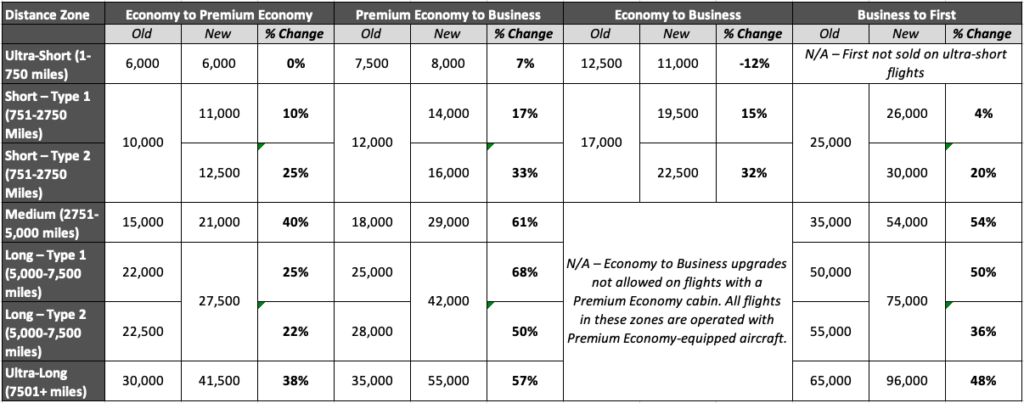
General trends of the new upgrade chart
1. The new short-haul upgrade redemption rates are fine…
Short-haul redemption upgrades have increased in price by around 10-30%. While some of the new redemption rates are quite high (especially for upgrades in the newly created Short – Type 2 distance zone), they’re nowhere near as bad as some of the redemption rate increases for long-haul flights. Economy to Business upgrades on ultra-short flights have even decreased in price.
Cathay has also recently upgraded its Premium Economy meal offering on short-haul flights over 3 hours to align with their meal offering in Business, which should take some of the pain away from the increased upgrade cost.
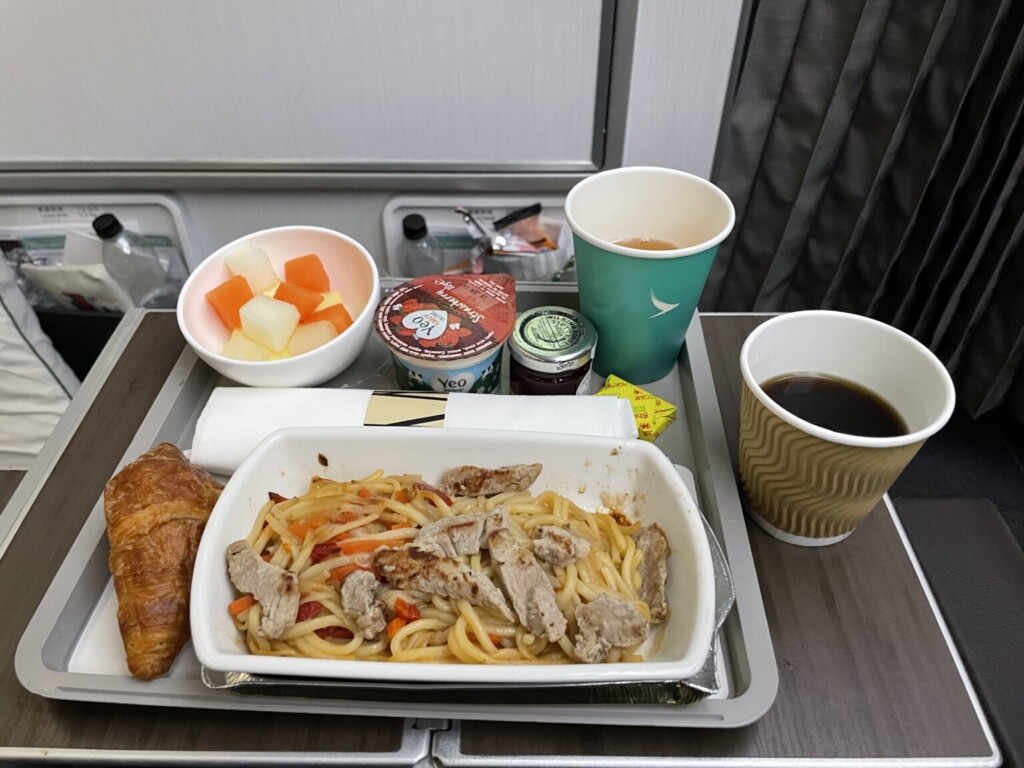
Cathay Pacific Premium Economy Meal
2. Economy to Premium Economy and Business to First upgrades get spared the worst of it
Economy to Premium Economy upgrade award rates on Medium and Ultra-Long flights have increased by around 40%. These changes are consistent with the widening price gap between Economy and Premium Economy. Despite the overall upgrade rate increases, I’d say that the devalued upgrade award rates – in some cases – still offer decent value.
Business to First redemption upgrade rates have, comparatively, gotten much less attractive. The new upgrade rates – which are 36-54% more than under the old award chart – represent a comparatively higher steep price increase. Asia Miles upgrades from Business to First are now so ridiculously expensive to the point where I can’t see any circumstance where such a redemption would offer good value – especially considering Cathay Pacific’s limited First Class footprint.
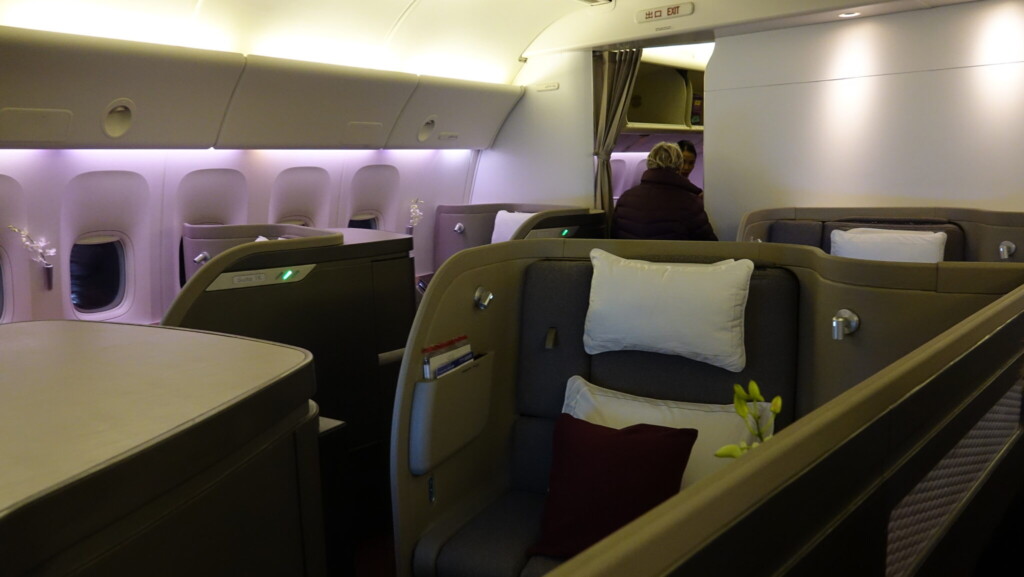
Cathay Pacific 777 First Class
3. Premium Economy to Business upgrades have been gutted
Without a doubt, the worst changes to Cathay’s award chart are the new rates to upgrade from Premium Economy to Business Class. The worst hit routes are those formerly in the “Long – Type 1” distance zone (destinations in Europe/South Africa/New Zealand), which will see a whopping 68% increase in the number of miles needed for an upgrade. Medium and Ultra-Long flights aren’t spared either, with redemption rate hikes of 61% and 57% respectively.
Premium Economy to Business upgrades have long been the sweetest spot in Cathay Pacific’s award chart, especially considering that the significant price difference between Premium Economy and Business tickets across much of Cathay’s network. Cathay also (typically) allows passengers to redeem an Asia Miles upgrade to any open seats at the time of check in, which made one-way Premium Economy to Business upgrades – in the past – consistently superb value.
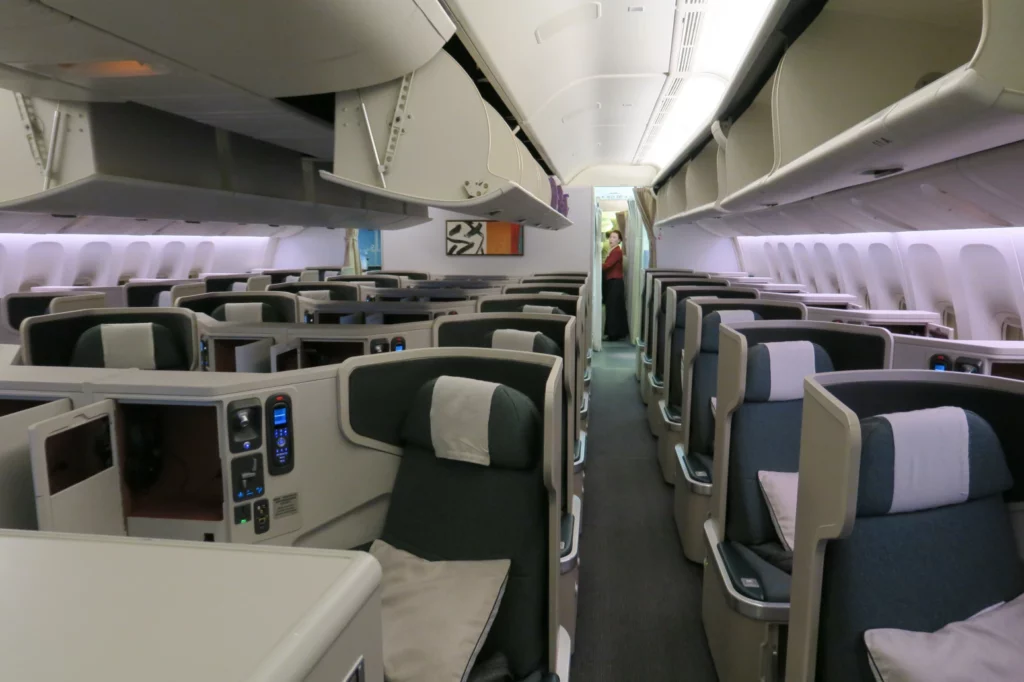
Cathay Pacific 777 Business Class
Unfortunately, it looks like Cathay has caught on to this. In contrast to some of the other mileage increases – which (somewhat) reflect changes both within the Cathay programme and market conditions – these price increases are clearly punitive and intended to discourage passengers from booking one-way Premium Economy to Business upgrades.
How I’m changing how I redeem my Asia Miles
Historically, I used Asia Miles for the main purpose of redeeming upgrade awards on ultra-long flights – which I find to be the sweetest spot in the programme. For example, I would typically try to find a good deal on an upgradable Premium Economy ticket and upgrade from Premium Economy to Business for 35,000 Asia Miles.
However, the new upgrade award chart basically eliminates the attractiveness of these bookings. The new upgrade award rates aren’t a deal-breaker – they’re just not the main thing that I would use my Asia Miles for anymore.
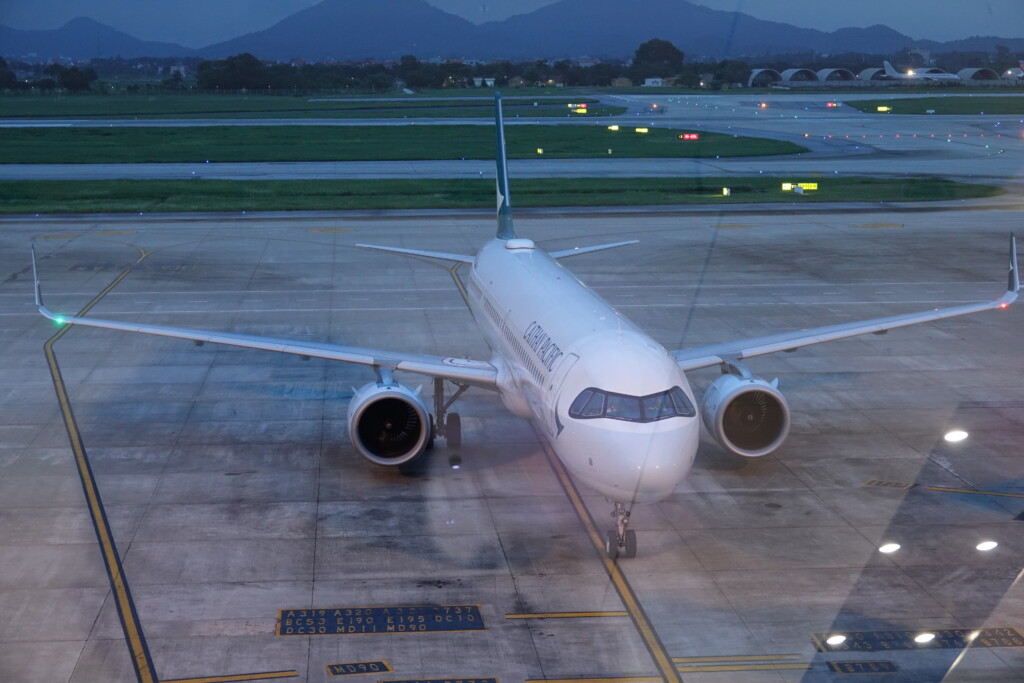
Cathay Pacific A321neo
Cathay’s short-haul award prices have emerged from the devaluation relatively unscathed. Considering how much short-haul paid tickets have grown in price, short-haul award redemptions are now much more valuable. However, it’s worth noting that there are plenty of other distance-based programmes with similarly attractive short-haul redemption rates.
Furthermore, despite lowered award redemption rates with the new award chart, I’m still not inclined to waste my Asia Miles on a long-haul Economy award redemption.
Bottom Line
Cathay will increase most award prices from the 1st of October, 2023. I have mixed feelings about the changes – while the award price increases are pretty fair, the programme has gutted its upgrade award redemptions, which were quite valuable. Overall, these changes make the Cathay programme less attractive – although truthfully, it’s not like the programme was known for its phenomenal award redemption rates in the first place.

Great post! Thanks Jason! Actually for me (being the points hoarder for a family with 3 kids), economy redemption has become a good proposition.
This past summer has been a case in point – crazy fares on long-haul flights to Europe (~HK$16k lowest economy return fare), so redeeming tickets actually made some sense. Points are indeed most most valuable for premium cabins, but: (1) good luck finding seat availability for 5 in business (and I’m not one for leaving kids in economy whilst parents sit in another cabin) especially over peak travel periods; and (2) I want my kids to consider economy class to be the norm (they can travel more comfortably when they have their own financial means to do so).
I just find it interesting how the value of a points redemption can also change depending on the stage of one’s life!